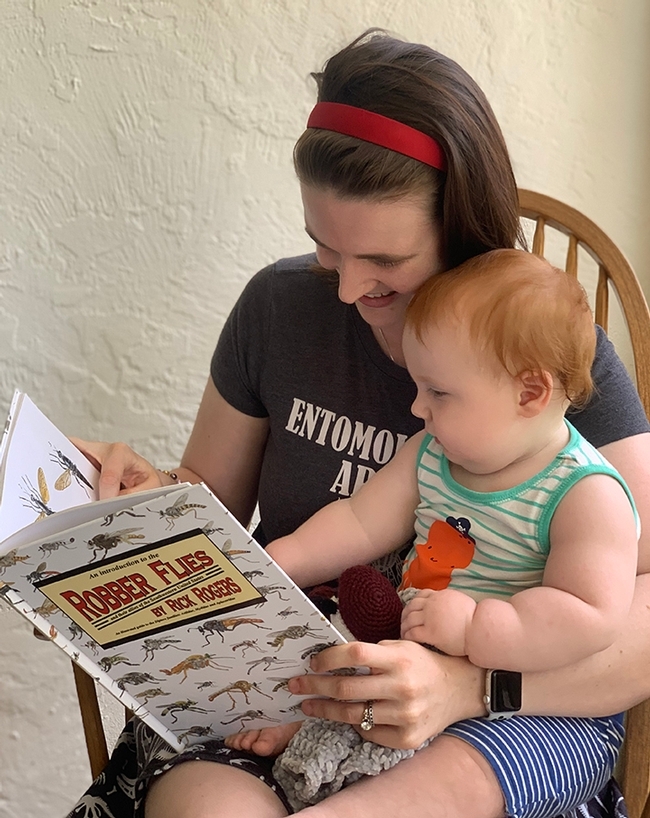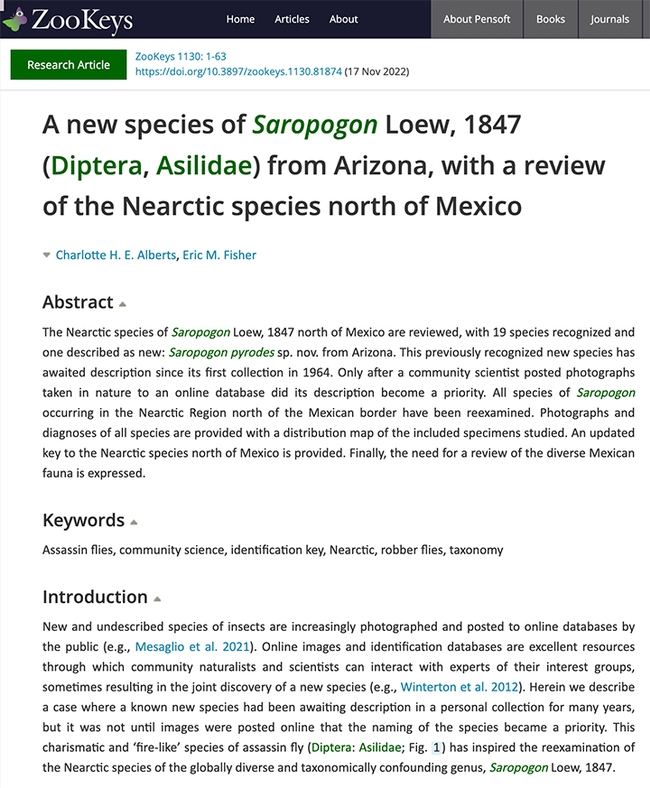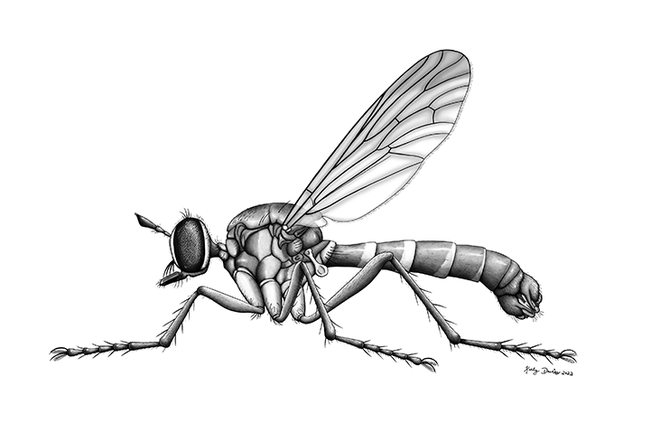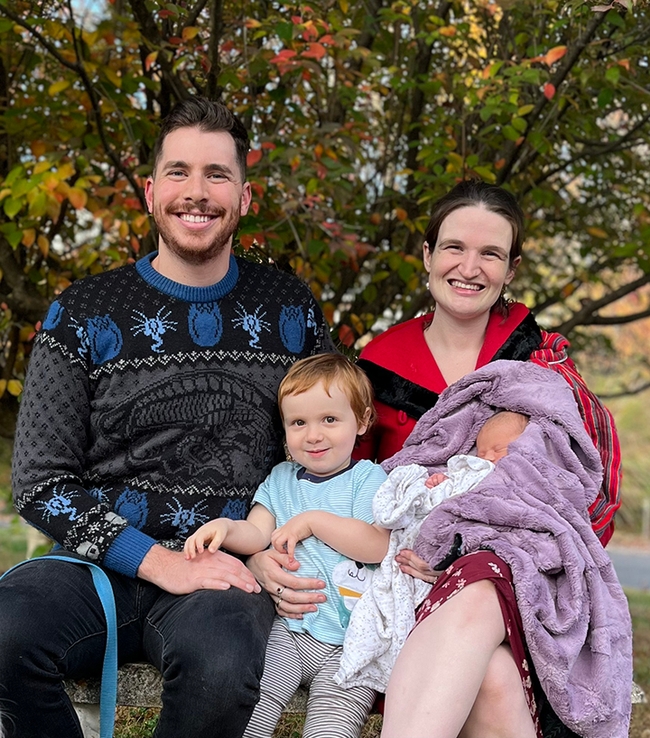
Now she has another day to celebrate: she recently published the first chapter of her dissertation on a new species of robber flies (also called assassin flies), in ZooKeys.
Alberts' paper, “A New Species of Saropogon Loew, 1847 (Diptera, Asilidae) from Arizona, with a Review of the Nearctic Species North of Mexico,” is her first journal publication.
“This new species of Saropogon (family Asilidae) was a known new species when it was collected for the first time in 1964,” Alberts said. “It wasn't until a community scientist posted pictures of this beautiful ‘fire-like' species to iNaturalist and BugGuide and requested identification that the description of this new species as well as a review of the entire Nearctic Saropogon, north of Mexico, became a priority. Publications like this are a great example of why community scientist and scientist engagement are so important. Websites like iNaturalist and BugGuide are an incredible resource for both and facilitate the finding and describing of new species.”
“This publication," Alberts said, "stands as the first chapter in my dissertation 'Assassin Fly (Diptera: Asilidae) Systematics and Predator Ecology.' After I receive my degree, my other two chapters will be published—hopefully shortly: ‘Chapter 2: Over 3400 Predator-Prey Records for Assassin Flies (Insecta: Diptera: Asilidae), Compiled from United States Entomological Collections' and ‘Chapter 3: A Molecular Phylogeny of Assassin Flies (Diptera: Asilidae) with Ancestral State Reconstruction of Arthropod Prey Preference.' ”
Alberts praised the work of macro photographer Jeff Gruber of Madison, Wisc., a regular contributor to BugGuide and iNaturalist who provided the Saropogon pyrodes image in ZooKeys, and UC Davis alumna Keely Davies, the illustration. Davies (biognome.art on Instagram) holds a bachelor's degree in animal biology (2019) and a degree in scientific illustration (2021) from California State University, Monterey Bay.

She moved cross-country during the COVID-19 pandemic in 2020 to finish her dissertation, all the while tackling multiple obstacles and health issues.
It's been a 5-year whirlwind: marriage in 2018 to artist George Albert, birth of their son Griffin in April 2020, and birth of their daughter Marceline “Marcy” in October 2022.
“I truly commend Charlotte for her recent publication of the first chapter of her dissertation," said Diane Ullman, UC Davis distinguished professor and a former chair of the Department of Entomology and Nematology. “She has overcome many obstacles, and I deeply respect her capacity to balance the science and research she loves, with being a mother of two, a wife and a devoted daughter.”
A resident of Silver Spring, Md., Charlotte enrolled in the UC Davis entomology graduate program in 2015, and anticipates receiving her doctorate in "no later than June 2023—hopefully before."
While at UC Davis, her accomplishments included serving as a teaching assistant for Professor Ullman in Entomology 001, “Art, Science and the World of Insects,” an art-science fusion course.
“Charlotte is a fantastic artist, as well as an excellent scientist,” Ullman said. I look forward to watching her as she finishes her Ph.D. and develops her career. My own daughter was born the year after I finished my Ph.D., and I certainly remember the challenge of being a mother, a wife, and taking care of aging parents while working to establish an academic career."
“Without a doubt," Ullman said, "I would not change a thing—I feel enormously grateful for the joy of my family, and for having the opportunity to simultaneously enjoy a full career in the sciences, as well as connecting art and science.”

A native of Plainfield, N.H, Charlotte is a 2015 graduate of St. Lawrence University, Canton, N.Y., where she majored in conservation biology and developed an interest in assassin flies--and in celebrating World Robber Fly Day every April 30.
Why assassin flies? “I chose assassin flies because I fell in love researching them as an undergraduate at St. Lawrence University,” she said. "They are fascinating flies and I like that they can immediately change someone's perspective of flies. They are venomous, predatory flies that eat other insects! And they sometimes even look exactly like the creatures they eat. Example: bumble bees!”
At UC Davis, she worked on the identification and database of the Asilidae collection at the Bohart Museum of Entomology from August 2015 until June 2021, while also engaged in numerous art projects and serving a year as secretary of the Entomology Graduate Student Association.
Charlotte has collected insects in 16 states and four countries, including Belize, Namibia, and Sweden. She presented a virtual seminar on “Asilidae of Belize” at the 2021 Entomological Society of America meeting.
How difficult is it to juggle so many roles? “I would be lying if I said it was easy,” Alberts said. “Being a mom, a wife, and a graduate student is a significant challenge. Balancing work and life is a skill that no one can teach you and takes a lot of trial and error. Thankfully, with the support and patience from my principal investigator (Diane Ullman), my advisor (UC Davis distinguished professor Rick Karban), my thesis committee (Ullman, research advisor Torsten Dikow of NNMH, and Jason Bond, Evert and Marion Schlinger Endowed Chair in Insect Systematics, Department of Entomology and Nematology, and associate dean, College of Agricultural and Environmental Sciences), my husband, and family, I have been able to continue to work on my PhD through a pandemic, multiple health issues, moving across the country, and having two children. Though being a mom and a graduate student is a lot of work, and exhausting, I wouldn't change it for the world. My family brings so much joy to my life and fuels me to push forward, one step at a time!”
Alberts noted that being a graduate student “has allowed me more flexibility as a working mom to also care for my children than a typical 9 to 5 job. Instead of putting the kids in daycare, I have chosen to work during nap times, after and before bedtime, for chunks during the day when my husband can take over, weekends, and during my son's preschool, twice a week. Sometimes it's challenging to not have the same routine every day. and there are never enough hours in a day, but I do get to be a part of my children's childhoods, and I am forever grateful for that!”
“Being a mom and a graduate student means that I am learning every day how to be more creative and flexible with my time,” she said. “I've learned how to modify my workspace to be available to my children. One of the many ways that having children has changed me is that I have less anxiety about my work. I used to sit on an email sometimes for days because of the fear of not being good enough or doing something wrong. Or sometimes, I wouldn't ask for help with something or ask how something was done because of the fear of being judged for not being able to do it myself. Since having my children, I've had to push my anxieties and fears aside because I simply don't have the time I used to have to worry about such things. I've learned to accept help from others and that I am not expected to know everything, especially in graduate school.”
Alberts remembers how much she liked interning at NMNH in the summer of 2014 and working with Dikow on identifying specimens of Asilidae to genus. She then won a graduate student fellowship (July-September 2016) at NMNH; Dikow served as her advisor. "I hope to do my postdoctoral fellowship there," she said.
Meanwhile, Charlotte Alberts is geared toward finishing her dissertation while balancing her work-home life. “My family brings so much joy to my life,” she reiterated, “and fuels me to push forward, one step at a time!”
Attached Images:
